Lexington History 1867 – Davis Bottom July 4 civil rights rally echoes all the way to US Senate

Above all else, Davis Bottom is the story of laborers, servants, railwaymen, tobacco workers, clergy and cooks. The people who helped make Lexington the commercial heart of the Bluegrass Region. It’s the story of grandparents, fathers and mothers, sons and daughters, ordinary families who built an extraordinary neighborhood as part of the Kentucky experience.
After the Civil War, thousands of newly freed African Americans left rural areas for cities such as Lexington in search of jobs, security and opportunity. From 1860 to 1870, Lexington’s Black population more than doubled from about 3000 to 7000. But housing was in short supply. Only a few property owners would sell or rent homes to blacks. Therefore, most African Americans settled into urban enclaves such as Brucetown, Kinkeadtown, Goodloetown, Pralltown, and Davis Bottom, close to downtown.
“Map of Ethnic Enclaves, Lexington, KY, ca 1865-1895,”
These neighborhoods were located near factories, railroads, stockyards and in swampy, disease prone areas known as bottomland. Bottomland is land that is low lying, easily flooded, and is unsuitable for use for agriculture and for what we would call estate building. But it was perfectly good to subdivide and to sell these lots to the newly freed African American or any immigrant family.
In the Davis bottom area, not only did we have African-American families, but we also had white families. Before development, Davis bottom contained a creek, marshlands, pastures, a school yard and two quarries. A railroad line ran along the northern ridge. The southern ridge held the remnants of a civil war fort. Fort Clay was one of two fortifications built in Lexington by the Union Army to defend against Confederate attacks.
In 1865, William Willard Davis bought and subdivided 43 narrow lots in the valley that now carries his name. Willard Davis was an attorney, a Republican politician, and a staunch advocate for civil rights. He was also a land speculator. Davis was one of several Republicans who developed neighborhoods for African Americans in Lexington after the Civil War.
1865 “Plat of Willard Davis
Subdivision,” Fayette County Clerk’s Office.
National politics played an important role in the early history of Davis bottom. On July 4th of 1867, a crowd of 10,000 people, mostly African-Americans, gathered for a day of picnics, music and speeches in a wood about a mile south of Lexington. It was one of the largest civil rights gatherings held in Kentucky during the period of Reconstruction. Willard Davis was a keynote speaker and one of the first residents of Davis Bottom was surely there.
“Fourth of July, 1867, Lexington, KY.”
Robert Elijah Hathaway, a Union Army veteran, was a founding member of the Kentucky State Benevolent Association, which helped organize the event. According to the Cincinnati Commercial, the immense crowd stood for hours, quietly listening to speeches from leading civil rights advocates. Reverend John Fee, Judge Goodloe, General Brisbane. Reverend Graham and Willard Davis. After supper, Davis spoke about the plight of blacks in Kentucky.
He decried state laws that prohibited African-Americans from testifying in state courts and from voting. This unprecedented gathering was sparsely covered in local newspapers, but the Cincinnati Commercial published a detailed description of the event, including the text of all of the speeches. Nine days later, Charles Sumner carried a copy of the Cincinnati commercial to a debate in the U.S. Senate over funding for the Third Reconstruction Act.
One of a series of reconstruction measures. The legislation would place Confederate states under military rule to enforce federal laws on basic civil rights. The debate turned into a heated argument between Senator Sumner of Massachusetts and Senator Garret Davis of Kentucky. Sumner was a leader of the radical Republicans who sought strict reconstruction measures. Garrett Davis, a member of the minority Democratic Party, favored more lenient legislation.
Davis accused Sumner of secretly lobbying to add Kentucky, which stayed with the union, to the list of Confederate states targeted for federal reconstruction. Davis also charged that stories from Congressmen of wrongs and crimes committed in southern states against blacks and union men were “the greatest fictions of this day.” In response, Sumner read excerpts from the speeches delivered on the 4th of July in Lexington.
He cited speech after speech describing the systemic oppression of blacks in Kentucky. Specifically, Sumner quoted the words of Willard Davis.
The U.S. Congress easily passed the third Reconstruction Act on July 19th, 1867.
Kentucky remained exempt. But the debate between Senators Charles Sumner and Garret Davis brought national attention to the social and political conditions for African-Americans living in Kentucky. The 4th of July gathering in Lexington was a landmark event for civil rights in Kentucky.
Speeches presented that day reverberated all the way to the U.S. Senate, and there at the forefront were two men with ties to Davis Bottom: Willard Davis, the neighborhood’s namesake, and Robert Elijah Hathaway, who just three years earlier had been enslaved. The property of U.S. Senator Garret Davis.
This article was adapted from a portion of a YouTube video produced by the Kentucky Department of Transportation for Davis Bottom History Preservation Project.
Recommended Posts

Lexington City Council to consider $400,000 aid for homeless families with schoolchildren
Fri, March 1, 2024

Bills aim to stop people from coming to Ky. to have Medicaid pay for addiction treatment; programs could have to get them home
Mon, February 26, 2024

How Will Lexington’s Economy Grow Over the Next Two Years?
Mon, February 26, 2024
